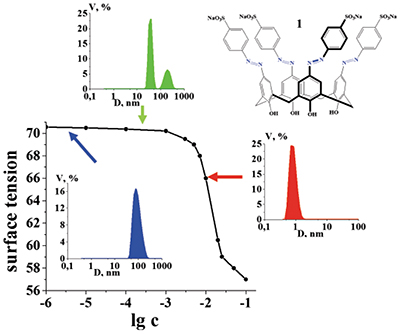Журнал "Макрогетероциклы"
Navigation
News
Impact Factor 2021 = 1.200 has been issued by ISI Web of Knowledge (JCR 2021).
Search
ISSN 1998-9539
Self-Organization and Physicochemical Properties of Aqueous Solutions of the Sodium Salt of Azosulphonate Calix[4]arene
Lyaisan I. Murtazina,a@ Irina S. Ryzhkina,a Maxim D. Shevelev,a Larisa A. Kostina,a Diana A. Sharapova,a Zaliya V. Akhmetzyanova,b Elena V. Popova,a Svetlana E. Solovieva,a,b Igor S. Antipin,a,b and Alexander I. Konovalova
aArbuzov Institute of Organic and Physical Chemistry, FRC Kazan Scientific Center, Russian Academy of Sciences, 420088 Kazan, Russia
bKazan Federal University, 420008 Kazan, Russia
@Corresponding author E-mail: LIMurt@yandex.ru
DOI: 10.6060/mhc190445m
Macroheterocycles 2019 12(4) 350-355
The self-organization and physicochemical properties of aqueous solutions of the sodium salt of azosulfonate calix[4]arene (1) were studied in a wide range of concentrations 1·10–10–1·10–1 M using a complex of methods. It has been found that the solutions of macrocycle 1 are in fact complex disperse systems, the nature of disperse phase in which changes with dilutions – from micelles (CMC = 2.5·10–2 М) and premicellar aggregates (1·10–2–1·10–3 М) of the size of 1 nm to supramolecular domains (1·10–3–1·10–6 М) with sizes of tens and hundreds of nm. Jointly using the methods of dynamic light scattering and UV spectroscopy it was shown for the first time that the nonlinear character of the concentration dependence of the optical absorbance (A360) in the concentration range 1·10–6–1.5∙10–5 М is a result of the rearrangements of supramolecular domains of 1, accompanied by the transition from bi- to monomodal pattern of particles’ size distribution, as well as by non-monotonic change in their size and ζ-potential. It was established that molecules of 1 are not capable of photoisomerization of the azobenzene group, which may be due to steric hindrances to the process of isomerization of closely located azoarylsulfonate groups located on one side of the plane of macrocycle 1.

| Attachment | Size |
|---|---|
| mhc190445m.pdf | 671.48 KB |
- 1183 reads
- Русский
